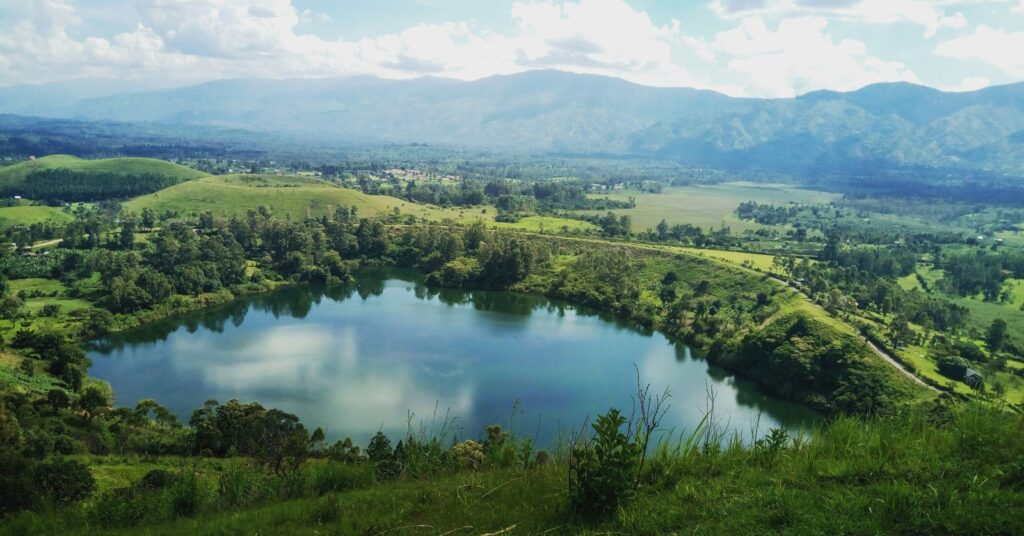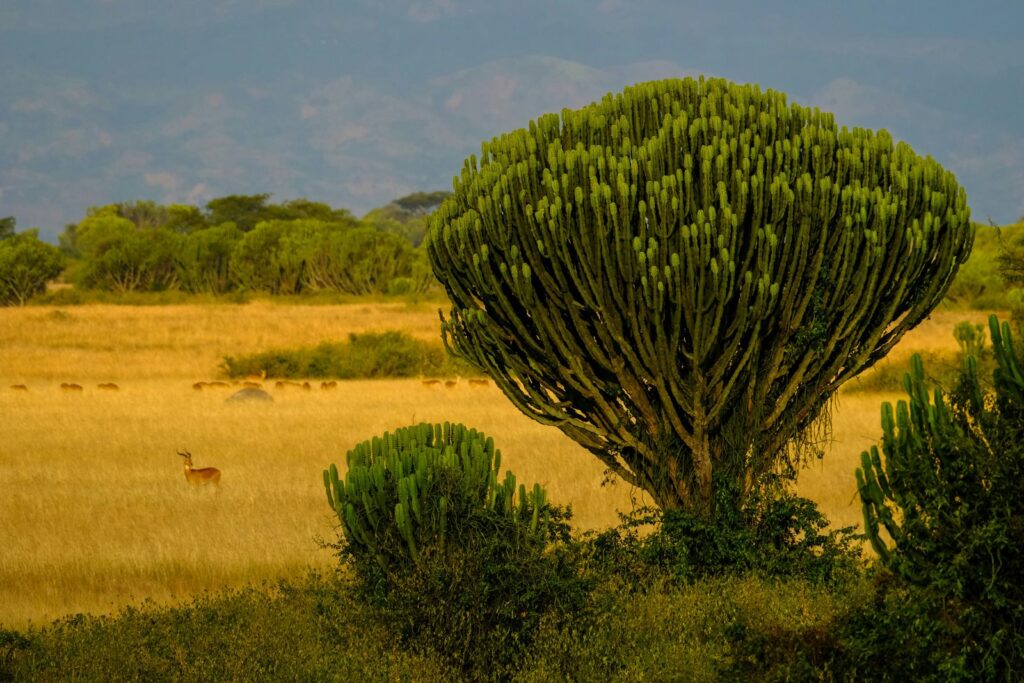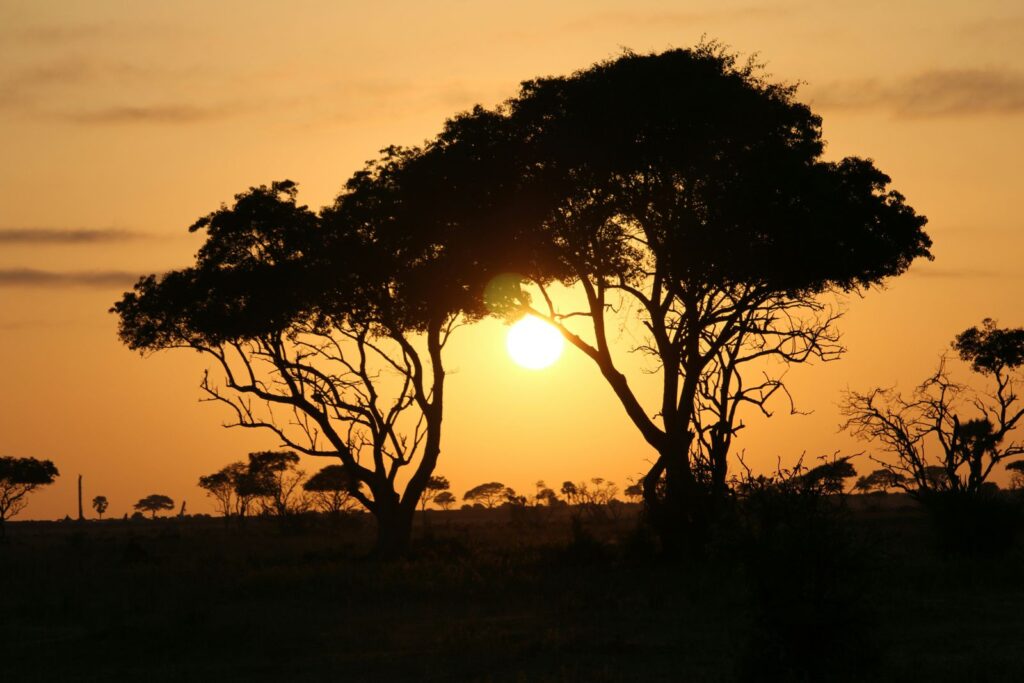Uganda, one of our most chosen destinations to experience volunteering.
This country is located in East Africa, bordering South Sudan to the north, Kenya to the east, Tanzania to the south, Rwanda to the southwest, and the Democratic Republic of the Congo to the west. Known as “the pearl of Africa,” it stands out for its impressive natural diversity, including savannahs, tropical rainforests, lakes, and rich wildlife, among which are mountain gorillas and tree-climbing lions.
Uganda’s natural diversity, as we mentioned, makes it a unique, spectacular, and unforgettable place for all those who visit it, and that is why today we want to talk to you about these landscapes and their impressive flora.

Its flora is rich and varied, thanks to its tropical climate, fertile soils, and ecological geography that makes Uganda one of the most biodiverse countries in Africa.
MAIN SCENARIOS
– Tropical forests
In regions such as the Bwindi Forest and Kibale National Park, dense jungles grow with tall evergreen trees, lianas, epiphytes (such as orchids and ferns), and a huge variety of medicinal and edible plants.
– Savannahs
In much of the central and northern part of the country, savannahs predominate, where acacias, trees from the Combretaceae family, and tall grasses are found. These areas are often home to many animal species.
– Wetlands and lake areas
Around Lake Victoria and other bodies of water, papyrus, reeds, water lilies, and other aquatic plants abound. These ecosystems are vital for biodiversity and water balance.
– Mountain flora
In the Rwenzori and Elgon Mountains, Afro-alpine vegetation can be found, with plants adapted to altitude such as giant lobelias, tree senecios, and heathers. These areas are unique for their endemism (species that do not exist anywhere else).
– Cultivated plants
Uganda is also agricultural, so bananas (matoke), coffee, tea, corn, beans, cassava, and many tropical fruits are grown. Some species, such as the East African highland banana, are fundamental to the local diet.

POPULAR TREES OF UGANDA
1. Mpafu (Ficus natalensis)
– Also known as the Natal fig, this tree is sacred in many Ugandan cultures.
– Its bark is used to make barkcloth, a traditional material and cultural heritage.
– It provides shade and is vital for forest ecosystems.
2. Mvule (Milicia excelsa)
– A large tree highly valued for its hard, resistant, and durable wood.
– Commonly used in construction, furniture making, and fine carpentry.
– It is currently threatened by overexploitation.
3. Ebony (Diospyros spp.)
– A tree famous for its black and dense wood, highly sought after in cabinetmaking.
– It grows slowly and is considered valuable both ecologically and economically.
4. Jacaranda (Jacaranda mimosifolia)
– Introduced ornamental tree that blooms with spectacular violet flowers.
– Found on streets and in urban parks, especially in Kampala and Entebbe.
5. Mango (Mangifera indica)
– Very common in rural and urban areas.
– Although not native to Uganda, the mango is fully integrated into daily life for its sweet fruits.
POPULAR FLOWERS OF UGANDA
1. Impatiens ugandensis
– Wildflower endemic to Uganda, with purple and white petals.
– Appreciated for its beauty and hardiness in ornamental gardens.
2. Orchids (Orchidaceae)
– Uganda is home to many orchid species, especially in its tropical forests.
– Some local orchids are endemic and highly sought after by botanical collectors.
3. African lily (Agapanthus africanus)
– Blue or white flower very popular in gardens and green spaces.
– Although found in several countries, it is widely cultivated in Uganda for its aesthetic value.
4. Hibiscus (Hibiscus rosa-sinensis)
– Very common in gardens and hedges for its striking red, pink, or yellow flowers.
– It also has medicinal and decorative uses.
5. Bougainvillea
– Vine with brightly colored bracts (pink, fuchsia, purple).
– Found in gardens and around houses as an ornamental element.

Many trees and flowers in Uganda have not only environmental value but also cultural and economic significance. Some species like the Ficus natalensis are used in traditional rituals, fruit trees are essential for rural food security, and ornamental flowers are part of the urban landscape and promote ecotourism.
If you are passionate about flora, Uganda will not leave you indifferent, and we know that its landscapes will help you create unforgettable memories.
At Cooperating Volunteers, we are waiting for you in Uganda.




